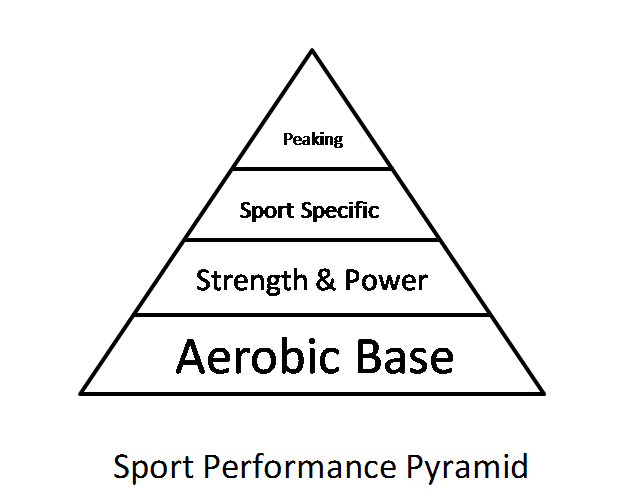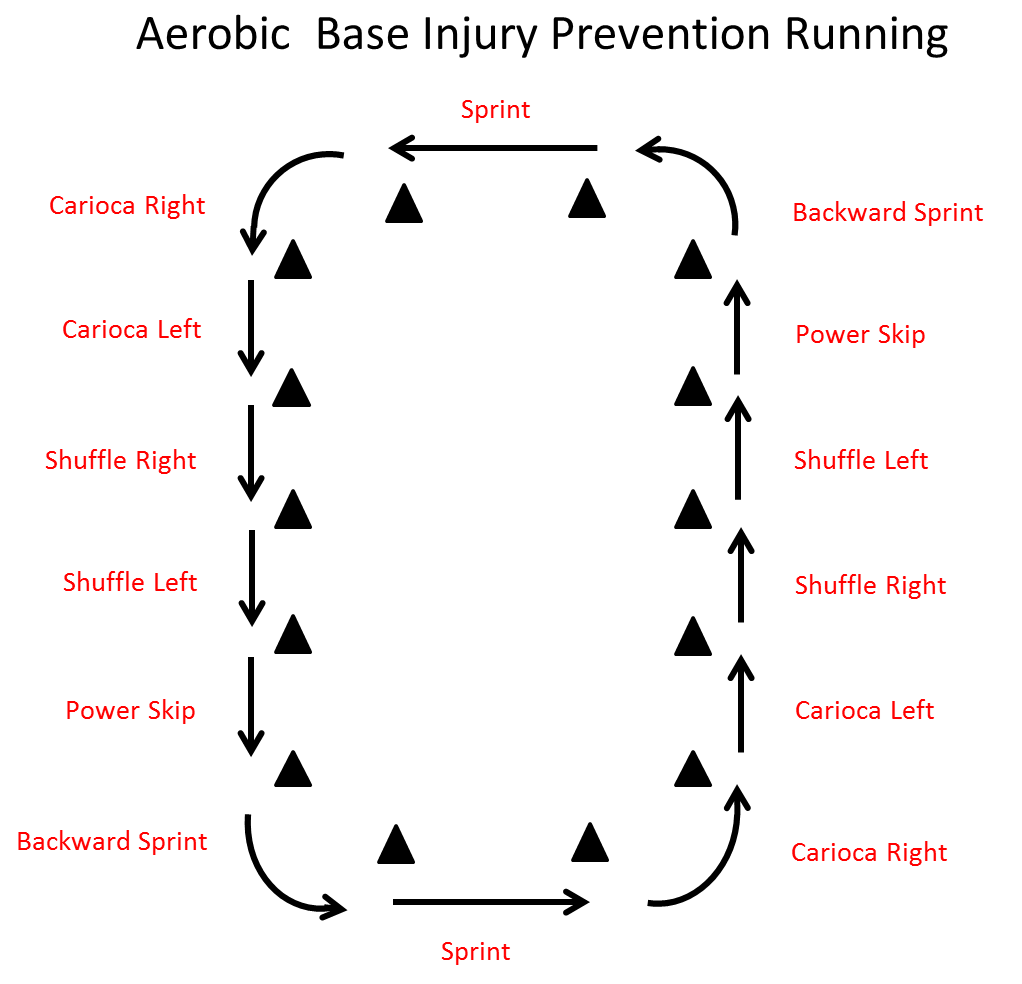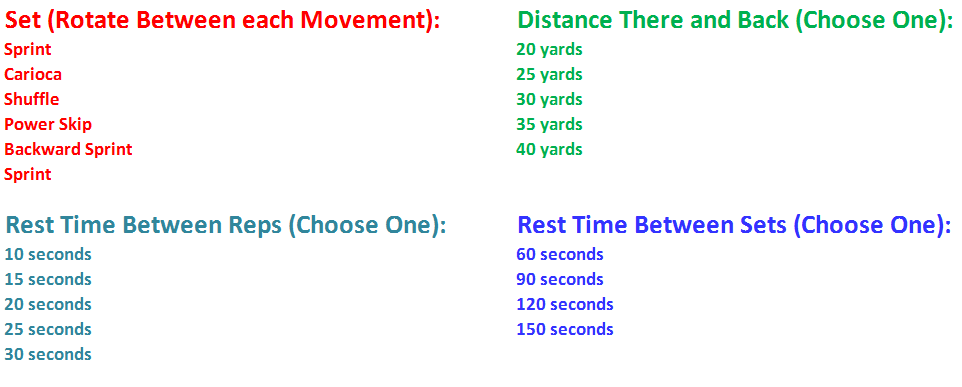
Triphasic Training Metabolic Injury Prevention Running
By: Matt Van Dyke and Cal Dietz
Aerobic training lays the foundation upon which all other methods of training are built. If this base aerobic training is ignored, specific, high-intensity training cannot be supported in later training cycles because an athlete will not achieve maximal benefits from the high-intensity work. “Metabolic Injury Prevention Running” enhances an athlete’s aerobic abilities, which is the main objective in the aerobic training cycle, while simultaneously working to reduce injuries to soft-tissue areas of the hip, groin, knee, and ankle. The reduction of injuries should be viewed as the primary goal of any coach and should be consistently and actively pursued. Metabolic injury prevention running focuses on both the reduction of injuries and training of the cardiovascular system, while keeping impact intensities minimal. Impact intensities can be kept relatively low in this aerobic training method due to the focus on movements that use the stabilizing muscles of the hip and groin area, such as shuffling and carioca. The activation and utilization of the stabilizer muscles leads to movement efficiency being reduced significantly when compared to running or sprinting in a straight line, while these commonly underused and injury prone muscles are strengthened and thus, less prone to injury. This method also can be used to prepare elite athletes for pre-season training camps or the competition season. The same movements are utilized as in the base endurance model, just at maximal intensities. This increased intensity further drives adaptations of the cardiovascular system while also continuing to reduce injury likelihood to the small, stabilizer muscles due to training muscle functioning and timing at high, game speed velocities. This high-intensity training prepares athletes with optimal conditioning levels and the increased ability to compete in their training camps.

Base Aerobic Training Aspects
Metabolic injury prevention running is used to drive extremely high levels of aerobic, cardiovascular fitness, which is the foundation upon which all other strength and conditioning abilities are built. This method of training allows for low-impact, high-intensity training by activating stabilizing muscles, particularly those of the hip and groin area. These stabilizer muscles are trained with the completion of non-typical running methods such as shuffling, carioca, and cross-over running. These methods of locomotion cause the body to work at a decreased level of efficiency which causes an elevation of the heart rate. It is important to note that the intensity will appear low at the start of this training piece as the athlete is moving at considerably lower speeds than when sprinting. The use of the commonly inactive and undertrained stabilizer muscles and movement patterns that cause the body to be less efficient than normal will lead to heart rate elevation to an aerobic training zone of 140-150 bpm. It is important to note that each athlete will have an individual heart rate response, but this range will give a general guideline if an athlete's exact heart rate training zones are unknown. Heart rate elevation can be manipulated based on the needs of intensity. The intensity can range from as low as 110 bpm up to the lactate threshold of each individual athlete, which ensures that aerobic intensities are kept and trained. The intensity to reach this training zone will typically fall between the 30 and 60% effort range for athletes. The low impact intensities allow this aerobic training method to be completed barefoot. This aerobic training method leads to an increase in work capacity which lays the foundation for future, high-intensity training that will be completed in later stages of the block periodization method.
Injury Resistance Aspects
The activation and then training of the stabilizing muscles of the hip and groin lead to increased functioning at higher levels of work, which reduce injury patterns. This is accomplished by training these underused and weak links of the kinetic chain in planes in which they are not typically trained. These stabilizing muscles are commonly the victims of soft-tissue injuries in the lower body simply because they are not strong enough to continue to support the increased strength of the primary movers. As a strength coach and an athlete, it is easy to train the primary movers, such as the glutes, quads, and hamstrings, due to their direct correlation with improved lower body strength and maximal speed. However, the mentality that “an athlete is only as strong as their weakest link” must be remembered at all times. If an athlete has the ability to squat an enormous amount of weight but has not taken the time to strengthen the stabilizing muscles, they will not be able to perform maximally and will deal with soft-tissue, stabilizer muscle injuries. These injuries, although minor in nature, will hinder their performance until the true issue is addressed. This issue is addressed head on with this metabolic injury prevention running method. The low impact intensities allow this aerobic training method to be completed barefoot. Training barefoot leads to increased strength in the plantar and dorsiflexors of the foot, while also strengthening the muscles of the lower leg. This develops and trains the foot to properly absorb impact and prevents shin splints and foot fractures. Barefoot training used in this lower-intensity training continues to contribute to injury prevention by improving strength levels in the commonly weak and underused muscles.
Game Speed Training
As the competition phase approaches and specificity of exercise selection is high, metabolic injury prevention running can be used to peak athletes before the rigors of their long, demanding season. The stabilizer muscles of the hip, groin, knee, and ankle are continually improved through the same movement patterns as described above, but they are now completed at maximum intensities. These high intensities will drive extremely high levels of cardiovascular fitness, even higher levels of cardiovascular fitness than sprinting, when distance and intensity are compared, as the body is continuing to move using inefficient movements. This game speed training using the methods of metabolic injury prevention running can be implemented during the final four to five weeks prior to the start of camp or the season and can be individualized based on position to increase specificity. Adaptations from this high-intensity method can be seen in as little as two weeks if an athlete is properly trained throughout the rest of the off-season, meaning they have had adequate aerobic training, as well as high-intensity training. The more specific movements made to the position and/or movements that will be completed in competition, the greater the benefits will be in injury reduction. This increased specificity leads to training the commonly underused and injury prone stabilizer muscles in the same planes they will be required to be used in competition.
Example Program
The keys of metabolic injury prevention running are the cardiovascular response and the strengthening of the stabilization muscles of the hip, groin, knee, and ankle. The target heart rate zone of this specific aerobic conditioning piece lies within 140-150 bpm. The first phase of metabolic injury prevention running includes three laps of low intensity, continuous jogging. The pace of jogging should give a heart rate response of about 110 bpm, which is an extremely low intensity. After the three laps are completed, the different running techniques such as shuffling, carioca, and backpedaling are implemented at the same pace as the low intensity jogging was completed. The inefficiency of the body through these movements will amplify the intensity and spike the heart rate into the goal aerobic heart rate zone of 140-150 bpm while keeping impact intensities low enough to train barefoot, thus strengthening the muscles of the ankle and foot. The intensity of these movements can be manipulated slightly as needed in order to attain a heart rate within this aerobic training zone. It is important to reiterate the speed of these movements does not need to be increased from the slow jogging since the heart rate will increase due to the movements being used in this method.
The example below shows how the five exercises used in this metabolic injury prevention running can be cycled through continuously. The cones can be set up anywhere between 20 and 50 yards apart. The key to this exercise is ensuring the lactate threshold of the athlete is not reached which is why an intensity of 140-150 bpm is set as the goal heart rate range. This method of training can be used with any set-up, even just two cones. This example falls in line with the use of metabolic injury prevention running around a concourse of an arena.

Game speed training with the metabolic injury prevention running method uses the same movements as above, just at maximal intensities. This high-intensity training method strengthens the stabilizer muscles and trains proper timing and firing rate of the stabilizers to prevent injury during competition. During game speed training, different positions can go through different movements, which increase specificity of training prior to the competition period. It should be noted this training should be completed with shoes on due to the high impact intensities.
The example of game speed training below shows the progression through this phase of training. Repetitions at this point of training can be completed based on time or distance, depending on how training is set up for that specific day. The same movements will be used during this progression, but will be completed at maximum velocities. The distance or time of each rep, rest time between reps and between sets, and the number of sets completed can all be determined based on each athlete’s individual needs to prepare them for a successful camp and/or season. In the example below, a single set is shown with the distance set of 15 yards from each other (30 yards there and back), 10 seconds of rest between each rep, with 60 seconds rest allowed after each set. The example shown is one of the more difficult programs of metabolic injury prevention running, as it uses minimal rest times between repetitions as well as between sets.


The off-season can be broken into 3 phases of conditioning training as follows.
Phase 1 – Off-Season Program – Figure 1
During this phase, base running and training are completed. This is the phase in which metabolic injury prevention running will be completed. This first phase of training typically lasts between 2 and 4 weeks, with the goal of creating a solid foundation of training which will allow more intense training as the off-season progresses. Metabolic injury prevention running can be completed between 2 and 3 times per week due to its low impact intensities and overall lower intensity on the body.
Phase 2 – Off-Season
Phase 2 consists of sport specific speed development and includes the qualities of acceleration, top end speed, and change of directions. The majority of the time within this phase will be spent completing as many sport specific drills as possible. This intermediate phase will last between 4 and 8 weeks to allow optimal development, with high quality work being the goal of each repetition.
Phase 3 Off-Season – Figure 2
This final phase of the off-season periodization consists of game speed conditioning. This will be completed 2 to 3 weeks prior to the beginning of training camp or the season. This phase is used as the final peaking method to prepare athletes for camp or an athlete’s season. It will offer optimal conditioning and injury prevention using maximal intensities. It should be performed at least twice a week, if not three times, when no other conditioning methods are being utilized. However, if speed development of athletes is still required, this quality can be trained throughout the week.